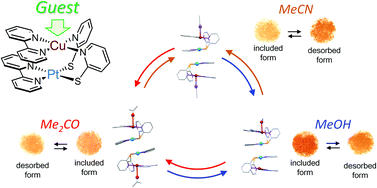Hysteretic vapour response of a heterodinuclear platinum(ii)–copper(ii) complex derived from the dimer-of-dimer motif and the guest-absorbing site†
Abstract
A heterodinuclear complex, syn-[PtCu(μ-pyt)2(bpy)2]2+ (syn-[PtCu]; Hpyt = pyridine-2-thiol, bpy = 2,2′-bipyridine), was synthesized by stepwise complexation. Three different crystal structures of the hexafluorophosphate salts with solvent molecules as guests at the axial sites of the Cu(II) ions, i.e. syn-[PtCu-G] (G = acetonitrile, acetone, and methanol), were determined by X-ray analyses. In the solid-state, these complexes adopt dimer-of-dimer motifs characteristic of the syn isomers of dinuclear complexes with two pyt bridging ligands arranged in a head-to-head configuration. These dinuclear complexes have a short Pt⋯Cu distance (2.75–2.81 Å) and slightly different intermolecular Pt⋯Pt distances (3.43–3.51 Å), which affect the colour of the solid complexes. All the syn-[PtCu-G] systems absorbed/desorbed vapour molecules; however, they exhibit different chromic changes because of the unique structural hysteresis of the desorbed form, i.e. syn-[PtCu], according to powder X-ray diffraction measurements. In addition, guest exchange occurred in the syn-[PtM-G] complexes upon exposure to the vapour of different solvents.


 Please wait while we load your content...
Please wait while we load your content...